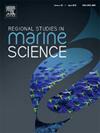Mercury speciation in a complex tropical estuarine system: Understanding natural and anthropogenic influences
IF 2.1
4区 环境科学与生态学
Q3 ECOLOGY
引用次数: 0
Abstract
Mercury (Hg) pollution is a major issue in many tropical estuarine systems. This study presents the distribution and speciation of mercury in Vembanad Lake (the largest estuarine system on the west coast of India), a RAMSAR site. It unravels how natural ligands control Hg speciation in the estuarine sediment system. Sedimentary Hg concentrations in the estuarine system varied from 3.5 ± 0.3 µg/kg to 50,105.0 ± 2505 µg/kg. The northern part of the lake exhibited exceptionally high sedimentary Hg concentrations (39.8 ± 2.4 µg/kg to 50,105 ± 2505 µg/kg), likely due to nearby industrial discharge. The central (3.5 ± 0.3 µg/kg to 116.0 ± 7.8 µg/kg) and southern regions (18.4 ± 1.1 µg/kg to 75.1 ± 1.0 µg/kg) had comparatively lower sedimentary Hg levels. Chemical speciation (Thermo-desorption technique) analysis revealed that sedimentary organic matter (SOM) acted as the primary host for Hg (21.6–100 % of total Hg), followed by sedimentary sulphides (SS) (below detection limit- 47.5 % of total Hg). The δ13C values for sediment samples ranged from −23.3 ‰ to −29.9 ‰. The end member mixing model indicates that SOM in the lake were derived from diverse sources, including terrestrial plants, soil OM, marine-derived organic matter, and anthropogenic activities like the coconut husk retting process. This study demonstrated how variations in natural ligand concentrations influenced the distribution and speciation of Hg in the system, and proposed a detailed mechanism for these processes. This study also suggests that activities related to disturbing sediment must be conducted cautiously to minimize Hg mobility and protect the ecosystem and human health in the region. The outcome of the research is expected to assist decision-makers in controlling Hg pollution in the estuary.
求助全文
约1分钟内获得全文
求助全文
来源期刊

Regional Studies in Marine Science
Agricultural and Biological Sciences-Ecology, Evolution, Behavior and Systematics
CiteScore
3.90
自引率
4.80%
发文量
336
审稿时长
69 days
期刊介绍:
REGIONAL STUDIES IN MARINE SCIENCE will publish scientifically sound papers on regional aspects of maritime and marine resources in estuaries, coastal zones, continental shelf, the seas and oceans.
 求助内容:
求助内容: 应助结果提醒方式:
应助结果提醒方式:


